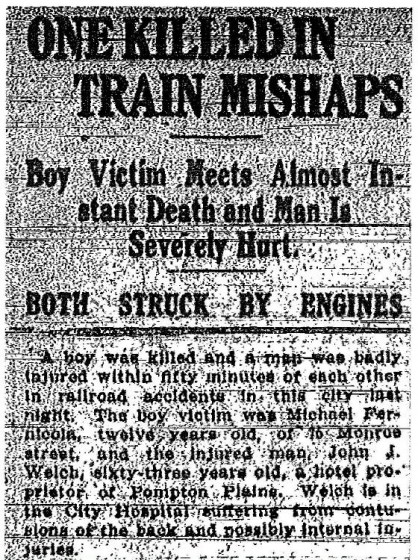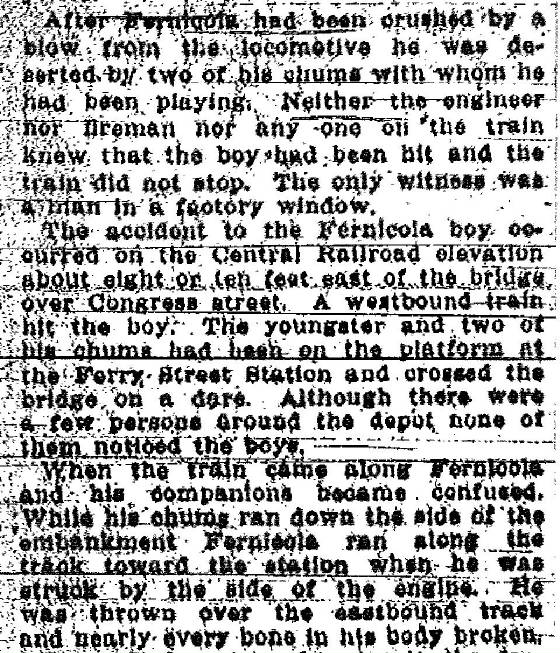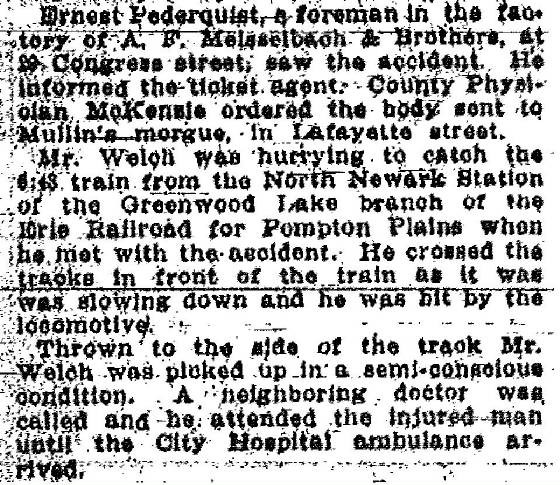
Lewis Hine caption: Smallest boy is Mike Ferinco, 75 Monroe St., 10 years old. Sells until 8:30 P.M., Newark, N.J. Other is Duar Feriari, 60 Monroe St. Sells until after 9 P.M. Location: Newark, New Jersey. December 1909.
The following appeared in New Jersey Review of Charities and Corrections, Volume 5, published in 1906, three years before this photo was taken.
Chief Attendance Officer McCall, of Newark, has made an interesting and valuable report of his department for the past year.
Badges and permits to the number of 915 have been issued to newsboys from this office since the ‘newsboys ordinance’ was passed. The enforcement of this ordinance is being attended with satisfactory results. Newsboys of school age are seldom found on the streets during school hours, and the crying, beggar-type of newsboy who was formerly seen on the main streets after midnight is now only observed on rare occasions. The attendance department has put forward its best efforts to steadily enforce this ordinance, and it has been necessary to arrest a number of boys for violation of it. All of the boys who were arrested were placed on probation in care of the chief attendance officer, except three, who were repeatedly arrested and finally committed to the Newark City Home.
Parents to the number of 218 have been summoned to the police courts during the year for the violation of the Compulsory Education law and for neglecting their children. Over 2,000 children have been placed in school during the year and have been compelled to attend regularly. The order of the chief of police that every uniformed officer when on duty during school hours should obtain names and addresses of all children found on the street and immediately report this to the attendance department has been well observed.
Formal complaint has been made by the chief attendance officer against ten parents and 219 boys and girls who were brought before the criminal courts charged with petty crimes or on complaints of incorrigibility made by their parents have been dealt with during the year. All of this has been done in connection with the county probation officers and the officers of the Newark City Home. Fifty-six boys were sent to the City Home, eight boys to the State Home for Boys and one boy and one girl were committed to the New Jersey Training School for Feeble-Minded Boys and Girls. Eight boys were recommended to be placed in care of the Children’s Aid Society, nine boys and two girls in care of the Catholic Children’s Aid Society, four girls in the House of the Good Shepherd, six boys in the Sacred Heart Protectory, one boy to the Berkshire Industrial Farm and one girl to the George Junior Republic, and the remainder recommended to be placed on probation or to be released to the parents with a warning. Boys to the number of 110 have been recommended by principals to be placed in the ungraded schools, and seventy-six were so transferred.
Lewis Hine took 12 photographs of Newark newsboys (and a girl in one case). Based on his captions and the photos themselves, it appears that they were taken on the afternoon, and possibly the evening, of Tuesday, December 17. The children were selling the Newark Evening News, the largest selling paper in Newark at that time.
Based on the US Census, the Newark City directories, and several other sources, the boy in the photo above, identified as Mike Ferinco, was Michael Fernicola. The other boy was Eduardo Ferraro (possibly Ferraro or Ferrari). I was unable to find any records of him or his family after 1910, so this story is about Michael only.
Michael was born in New Jersey (probably Newark) about 1900. His parents were Nicola (later spelled Nicholas) and Antonia. They married in Italy in 1894, and immigrated to the US through Ellis Island on May 18, 1896, along with their first child, one-year-old Giuseppi (Joseph). The family does not appear in the 1900 census, but are listed as early as 1906 in the Newark City Directories.
By then, Mr. Fernicola owned a grocery store on the first floor of an apartment building at 75 Monroe Street. He also owned the building, lived in it, and rented the other apartments. By 1910, they had six more children, including Michael, now about 10 years old. He and the rest of the children over five years of age were attending school, so it appears that Michael was complying with the newsboys ordinance cited above. In the photograph, he and the other boy appear to be wearing some sort of badge, which is hanging around their necks, also in compliance with the ordinance.
Nicholas still owned the grocery and building on Monroe Street. They probably were parishioners at Our Lady of Mt. Carmel Roman Catholic Church, on Ferry Street. Originally constructed as the Second Dutch Reformed Church in 1848, it was converted to a Catholic church in 1890, by Italian immigrants.
The Fernicolas lived in the Ironbound section of the city. The name comes from the fact that the area was known for its metalworking industry and large network of railroad tracks that surrounded the neighborhood. Ironbound was poorer than the rest of Newark at that time, and was populated by a variety of immigrant groups. Saloons served as major meeting places for Ironbound workers, a situation that concerned social welfare agencies. One social worker, in a report published in 1912, cited a survey that counted 122 saloons in Ironbound.
Ironically, Michael and his newsboy partner (who lived less than a block from him) were standing near one of those saloons, owned by Andrew Martin, and located at 277 Market Street, about a half-mile from Michael’s home, and about two blocks from the headquarters of the Newark Evening News. On the day the photo was apparently taken, an advertisement appeared in the Evening News. Placed by J. Lissner & Sons, a store also located in Ironwood, the ad featured 52-inch genuine Hudson seal coats for $65, probably not a hot item among Ironbound’s poor immigrants.
I found the Fernicola family again in the 1920 census, now in a two-family apartment building owned by Mr. Fernicola, at 143 Monroe Street. He was listed as a laborer, so it appears that he had sold the store and building at 75 Monroe. He was now listed as a widower. I could not confirm when his wife died, but the census lists an additional child born in 1911, so it’s possible that his wife died in childbirth in 1911. Michael was no longer living at home, but I could not find him listed elsewhere in the 1920 census or city directory, nor in any subsequent censuses or directories. And I couldn’t find him in any official death records, either. So I tried FindAGrave.com, and there he was.
Sadly, he died May 2, 1912, just 29 months after Hine took his picture. He is buried at Holy Sepulchre Cemetery, in nearby East Orange. I could not find any information about the cause of death, so I searched his name on the Web and came up with the following in Annual Statements of the Railroad and Canal Companies, published in 1912 by the New Jersey Comptroller of the Treasury. It was listed under the heading, “Central Railroad Co. of New Jersey, struck by trains, locomotives or cars at points along the line, non-employees.”
May 2, 1912 – Michael Fernicola, trespasser, killed at Ferry Street, Newark. Engineer, J. Koehler; conductor, Cyrene Warman.
According to the same source, there were 44 pedestrian/non-employee accidents involving the Central Railroad of New Jersey in 1912, resulting in 24 deaths and 20 injuries. Five of the accidents occurred in Newark, three of which happened on Ferry Street. At the time, there were two railroad stations on that street, both located a short walk from Michael’s home.
I was unable to find any living descendants of his siblings, although it would be unlikely that any who are still living would remember anything about Michael. After all, he died 103 years ago.



*Story published in 2015.